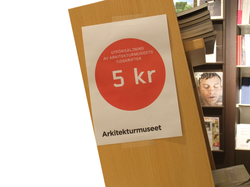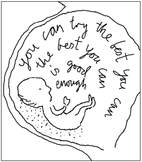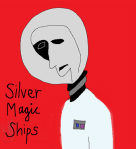
The highlight of the festivities focused on the commemorative publication, The Swedish Museum of Architecture: A Fifty Year Perspective. This was launched following a series of reflections by two contributors to the book, Thordis Arrhenius and Bengt O.H. Johansson (the latter was director of the museum from 1966-77).
This was followed by a panel debate entitled “Midlife crisis or stroppy teenager? A discussion about Arkitekturmuseet yesterday, today, tomorrow”.(1) It was at this point that matters started to get interesting. It quickly became apparent that the past, present and future of Arkitekturmuseet are far from settled. Much attention was given to the recently expanded role of the museum. This is summed up in an introductory section of the anniversary book. Under the rubric, “More than a museum”, Monica Fundin Pourshahidi cites a press release by the Swedish minister of culture, Lena Adelsohn Liljeroth in which it is stated that, from 2009 onwards, Arkitekturmuseet is vested with being a “power centre” not only for architecture but also for design: “The Museum of Architecture can and must be a display window and a distinct voice in the debate on social planning, architecture, design and sustainable development”.(2)
This point was taken up by Arkitekturmuseet’s present director, Lena Rahoult. But her positive spin was immediately problematised by a fellow panel member, the architectural historian Martin Rörby. The focus of his criticisms was a recent governmental memorandum which instructed the institution to engage in “promotion and communication” (främjande och kommunikation) rather than “traditional museum activities” (traditionell museiverksamhet). This would be best signalled by a change in title, with the word “museum” being replaced by “centre” or “arena”.(3)
Rörby expressed reservations about such a shift in focus, fearing that an increase in breadth would come at the expense of depth and critical engagement. He was also troubled by the vague, empty rhetoric of the memorandum. On the other hand, the notion of going beyond what was expected of a “traditional” museum was nothing new. Rörby illustrated this point by citing Arkitekturmuseet’s past involvement in the often heated debate regarding Sergels torg in central Stockholm. He stressed the rapidity of the museum’s response which enabled it to react to a pressing, contemporary issue. This active engagement, however, was only possible because of the museum’s unrivalled collections of artefacts, architectural models and other archival documents. Rörby was of the opinion that the museum would find it far harder – if not impossible – to arrange such an exhibition in the additional field of design. This is because the museum responsible for the national design collection is another entirely separate institution, namely Nationalmuseum. The design holdings will remain there, despite Arkitekturmuseet’s increased mandate.
In the light of this one can be forgiven for questioning the basis for adding design to the museum of architecture. The oddness of this situation was beautifully demonstrated by the fact that, at the very same time that this debate was unfolding at Arkitekturmuseet, Nationalmuseum just down the road was holding a “theme day” on “handicraft, time and creativity” in association with its craft and design exhibition, Slow Art.(4)
Way back in the late 1980s and early 1990s the museum fraternity in Sweden dreamed of a museum of industrial design (Konstindustrimuseet) being housed in Tullhuset adjacent to the main Nationalmuseum building in the Blasieholmen area of Stockholm. This nineteenth century toll house was to have been expanded to allow for 5000 square metres of exhibition space. Alas, this imaginative idea proved abortive, as did a plan to deploy the spectacular Amiralitetshuset on the island of Skeppsholmen.(5)
In the wake of these failed initiatives comes the current half-baked decision to place the design burden on the ill-equipped museum of architecture. Meanwhile, in February 2013, Nationalmuseum will close for a period of four years during which time a multi-million kronor refurbishment will take place. This, one would have thought, would be the ideal opportunity to resolve the status of design in Sweden. The risk is that the investment in Nationalmuseum is being made against a contested, confused and contradictory context.
Exacerbating this frankly farcical state of affairs is the added complication of Arkitekturmuseet’s relationship with Moderna Museet. These two museums, as has been noted, share a building. One might therefore have thought that it would sensible for the pair to unite, especially given the enlarged remit of Arkitekturmuseet. Indeed, in 1998 it was proposed that modern design dating from 1900 onwards should be moved to Moderna Museet.(6)
On being asked about the relationship with her neighbour, Arkitekturmuseet’s director Lena Rahoult made a few platitudinous comments and paid compliments to Daniel Birnbaum, her counterpart at Moderna Museet. However, when it comes to Moderna Museet’s upcoming exhibition on Le Corbusier, it emerged that the museum of architecture will not be involved.(7) This, it strikes me, represents a potentially serious threat to the autonomy of Arkitekturmuseet. If the Le Corbusier exhibition is a success despite (or perhaps because of) the exclusion of Arkitekturmuseet, then the argument is being made that Moderna Museet is more than capable of taking over this field.
Daniel Birnbaum would no doubt be delighted. He is a very shrewd operator. Upon taking over the running of Moderna Museet he erased all trace of its former director in the most charming manner: by turning the whole museum over to photography. This had a number of consequences. It facilitated a tabula rasa whilst showing Birnbaum to be both innovative and in step with the history of the museum. This in turn stifled any potential suggestion that photography was not being accorded sufficient attention. This was a smart move given that the formerly separate museum of photography had been subsumed into the collections of Moderna Museet on the completion of Rafael Moneo’s building in 1998. With this potential criticism snuffed out, Birnbaum then set about curtailing the independence of the museum’s satellite institution, Moderna Museet Malmö. This was led by Magnus Jensner until a “restructuring” made his position untenable and prompted his resignation.(8) In March of this year Jensner was succeeded by Birnbaum’s man in Stockholm, John Peter Nilsson.
Against the background of these strategic manoeuvres the decision to mount an exhibition on Le Corbusier at Moderna Museet is no mere innocent happenstance. It can be interpreted as part of a calculated empire building process. And, if the recent debate at Arkitekturmuseet is anything to go by, Birnbaum is a giant among pygmies on the Swedish cultural scene.
Perhaps mindful of this, at the same time as spouting her platitudes, Lena Rahoult has been busy mounting the barricades. She has taken the decision to withdraw Arkitekturmuseet from the bookstore that it has shared with Moderna Museet since the inception of Moneo’s building. All the books are being sold at a reduction of 60% whilst magazines and postcards are being flogged off for a few kronor. Once this stock has been disposed, Arkitekturmuseet will open a separate retail establishment in its own part of the locale. This development is notable given that the bookstore was one of the very few aspects of the building where the two institutions merged. Another is the shared ticket desk. Moneo designed the building to incorporate the old drill-hall where Moderna Museet began life and which is now occupied by Arkitekturmuseet. In so doing he provided a new entrance and closed the original doorway. Rahoult plans to reopen this entrance whilst keeping the other in use. Birnbaum is on record as describing this proposal as “ludicrous” (befängd).(9) Well he might, because one of the main criticisms of Moneo’s building is its very modest and hard-to-find entrance. Should Arkitekturmuseet prove to be the main gateway into the combined museum it may well increase the number of visitors to the architecture collection, but it will draw attention from what is currently the dominant partner, Moderna Museet.
The proposed changes to the shop and entrance have led to claims that Arkitekturmuseet wishes to “break free from Moderna Museet”.(10) The paradoxical situation has therefore arisen whereby, at the same time that Arkitekturmuseet struggles to work across disciplines in one direction, it is placing barriers to the museum next door.
There is, of course, no reason why different disciplines should not be brought together in a single museum. A case in point is the Museum of Modern Art, MOMA. Its mission statement is grounded in the belief
[t]hat modern and contemporary art transcend national boundaries and involve all forms of visual
expression, including painting and sculpture, drawings, prints and illustrated books, photography,
architecture and design, and film and video, as well as new forms yet to be developed or understood,
that reflect and explore the artistic issues of the era.(11)
Another example closer to home is Norway. However, in this case the forced union of art, architecture and design has been far from amicable or straightforward. But at least Norway’s National Museum of Art, Architecture and Design is being given a grand new building in which to unite. This is not the case in Sweden. No one should be surprised about this given the paltry cultural policies of the present alliance government under the stewardship of its mediocre minister of culture, Lena Adelsohn Liljeroth.
When it came to the festivities to mark Arkitekturmuseet’s jubilee debate, the icing on the birthday cake occurred when the panel turned to the audience for questions and response. Up stepped Jöran Lindvall. He remains – as he was at pains to make clear – the longest serving director of Arkitekturmuseet (during the years 1985-1999). Nevertheless, he added pointedly, no one had thought to ask him to contribute to the fiftieth anniversary publication. His absence from its pages was a timely reminder that such official records are as partial as they are political. That much is shown by a similar publication released to mark Moderna Museet’s own fiftieth anniversary in 2008.
Such historical tomes might seem to be rooted in the past, but their main aim is to seek to placate the politicised present whilst simultaneously shaping the uncertain future. As if to underline this, Jöran Lindvall presented the current holder of the post he once occupied with a bag stuffed full of newspaper cuttings and other documents from his private collection relating to exhibitions that took place during his time at the museum. He declared his willingness to donate these to Arkitekturmuseet, but on one condition: that it remain a museum devoted to architecture. Lena Rahoult accepted this generous offer. She could hardly do otherwise.
It will be interesting to follow the fate of Lindvall’s loaded gift. Indeed, all those involved in museums would do well to keep track of events in Sweden and watch with interest as commentators, practitioners, museum professionals and politicians plot their next moves in a battle that is more comedy than tragedy.
But that is not to say that the outcome is likely to leave very many people laughing.
_____
Notes
(1) The panel participants were the director of Arkitekturmuseet, Lena Rahoult together with Fredrik Kjellgren (architect), Petrus Palmér (designer), Birgitta Ramdell (director of Form/Design centre, Malmö) and the architectural historian Martin Rörby (Skönhetsrådet). The chair was Kristina Hultman.
(2) Press release dated 19 December 2008, cited in Main Zimm (ed.) The Swedish Museum of Architecture: A Fifty Year Perspective, Stockholm: Arkitekturmuseet, p. 4.
(3) Cited in “Stora förändringar föreslås på Arkitekturmuseet”, Arkitektur, undated, http://www.arkitektur.se/stora-forandringar-foreslas-pa-arkitekturmuseet (accessed 12/11/2012).
(4) Slow Art, Nationalmuseum, 10 May 2012 – 3 February 2013. The special event that took place on Sunday 11 November included a talk by Cilla Robach (“Slow Art – om hantverk, tid och kreativitet”) followed by a craft activity for children (see the advertisement on p. 7 of the Kultur section of that day’s issue of the newspaper, Dagens Nyheter).
(5) Mikael Ahlund (ed.) Konst kräver rum. Nationalmuseums historia och framtid, Nationalmusei skriftserie 17, 2002, pp. 76-77.
(6) Ahlund, 2002, p. 77.
(7) Moderna Museet’s exhibition has been given the name “Moment – Le Corbusier’s Secret Laboratory” and will run from 19 January – 28 April 2013. The decision not to collaborate with Arkitekturmuseet is ironic given that the latter put together the exhibition “Le Corbusier and Stockholm” in 1987.
(8) “Magnus Jensner slutar i Malmö”, Expressen, 20/10/2012, http://www.expressen.se/kvp/magnus-jensner-slutar-i-malmo.
(9) “Arkitekturmuseets femtioårskris – en intervju”, Arkitektur, undated, http://www.arkitektur.se/arkitekturmuseets-femtioarskris-en-intervju (accessed 12/11/2012).
(10) Hanna Weiderud, “Arkitekturmuseet bryter sig loss från Moderna”, SVT, 01/11/2012, http://www.svt.se/nyheter/regionalt/abc/arkitekturmuseet-bryter-sig-loss-fran-moderna.
(11) Collections Management Policy, The Museum of Modern Art, available at, http://www.moma.org/docs/explore/CollectionsMgmtPolicyMoMA_Oct10.pdf.






